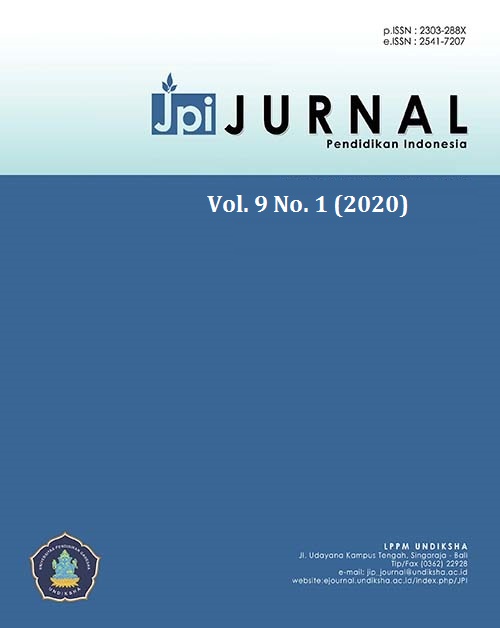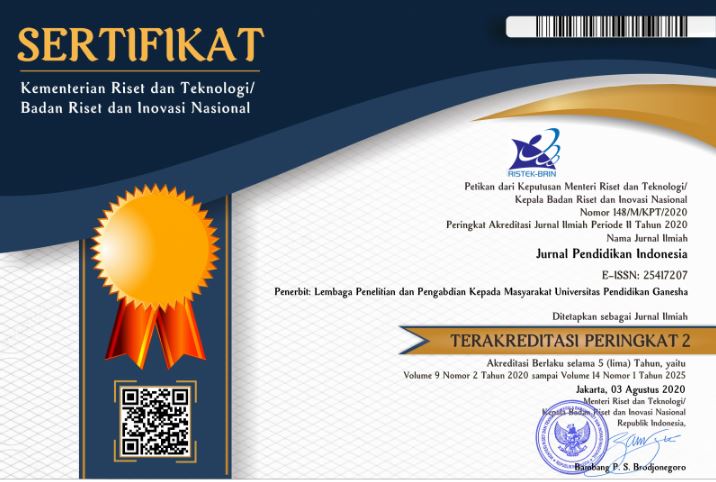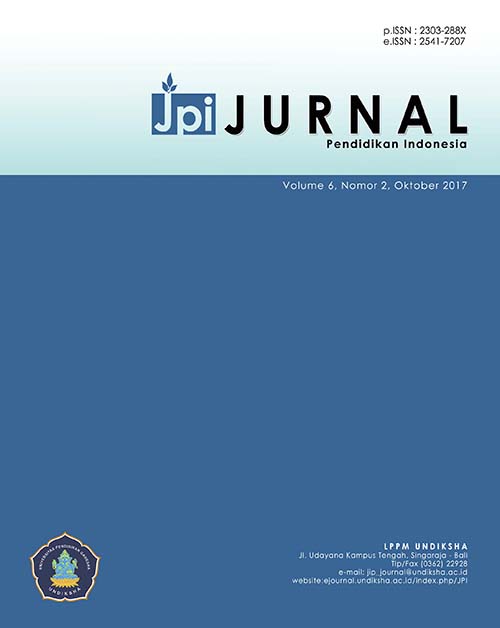The Synchronous Online Argumentation System User Interface with an Integrated Design Framework: Redesign and Evaluation
DOI:
https://doi.org/10.23887/jpi-undiksha.v9i1.23104Kata Kunci:
Synchronous Argumentation System, Design Principles, User Interface, Design Framework, EducationAbstrak
The Synchronous online argumentation system is highly needed to facilitate learning activity in this internet era. To gain deeper insights about this important issue, this study developed nine principles based on Cognitive Load, User Interface, and User Experience to redesign a system. With this framework, 48 (forty-eight) students of Chi-Ying High School had tested with two prototypes, and the second prototype used the nine principles. The systems were measured with Web-Based Learning Environment (WEBLEI) and System Usability Test (SUS). The result of WEBLEI measurement shows that the second prototype gives better result and shows higher user acceptance than the first prototype. The result of SUS measurement shows that the usability of the second prototype is better than on the first prototype with (4.43) SUS score difference. The result shows that the use of nine principles that applied to the second prototype does increase the usability and acceptance of the students.
Referensi
Almeida, F., & Monteiro, J. (2017). The role of responsive design in web development. Webology, 14(2), 48–65.
Asraj, A. Al, Freeman, M., & Chandler, P. A. (2011). Considering cognitive load theory within e-learning environments. PACIS 2011 - 15th Pacific Asia Conference on Information Systems: Quality Research in Pacific, 1–13. https://ro.uow.edu.au/cgi/viewcontent.cgi?article=2288&context=infopapers
Botturi, L., Lepori, B., & Tardini, S. (2006). Fast Prototyping as a Communication Catalyst for E-learning Design. Making the Transition to E-Learning: Strategies and Issues, January, 266–283. https://doi.org/10.4018/978-1-59140-950-2.ch016
Brink, T., Gergle, D., & Wood, S. D. (2002). Usability for the Web DesignWeb sites That Work. Morgan Kaufmann Publishers.
Chang, V. (2014). The Web based Learning Environment Instrument ( WEBLEI ). 1996, 6–11.
Chen, N. S., Ko, H. C., Kinshuk, & Lin, T. (2005). A model for synchronous learning using the Internet. Innovations in Education and Teaching International, 42(2), 181–194. https://doi.org/10.1080/14703290500062599
Costa, C. J., Costa, P., & Aparício, M. (2004). Principles for creating web sites: A design perspective. Principles for Creating Web Sites: A Design Perspective, January, 484–488.
Gullà, F., Ceccacci, S., Germani, M., & Cavalier, L. (2014). Design Adaptable and Adaptive User Interfaces: A Method to Manage the Information. Research Trends in Media Informatics, 426(April), 39–46. https://doi.org/10.1007/978-3-319-18374-9
Hotcomm. (2003). Synchronous Tools and the Emerging Online Leaming Model. 1–4. http://hotcomm.com/tec/dlwp.pdf
Hrastinski, S. (2007). Participating in Synchronous Online Education. In Management. School of Economics and Management, Lund University. KFS AB. http://lup.lub.lu.se/luur/download?func=downloadFile&recordOId=599311&fileOId=600490
Jitnupong, B., & Jirachiefpattana, W. (2018). Information System User Interface Design in Software Services Organization: A Small-Clan Case Study. MATEC Web of Conferences, 164. https://doi.org/10.1051/matecconf/201816401006
Jönsson, D. H. (2020). The emancipatory potential of child-computer interaction (Issue February 2019, pp. 1–13). https://uxdesign.cc/the-emancipatory-potential-of-child-computer-interaction-e84f7a95a3d0?gi=ebddd1826fd
Leidner, D. E., & Jarvenpaa, S. L. (1995). The Use of Information Technology to Enhance Management School Education: A Theoretical View. Journal - Association of Official Analytical Chemists, 71(3), 557–559. https://doi.org/10.1093/jaoac/71.3.557
Lestari, D. M., Hardianto, D., & Hidayanto, A. N. (2014). Analysis of user experience quality on responsive web design from its informative perspective. International Journal of Software Engineering and Its Applications, 8(5), 53–62. https://doi.org/10.14257/ijseia.2014.8.5.06
Machado, E., Singh, D., Cruciani, F., & Chen, L. (2018). A Conceptual framework for Adaptive User Interfaces for older adults. A Conceptual Framework for Adaptive User Interfaces for Older Adults: IEEE International Conference on Pervasive Computing and Communications Workshops, PerCom Workshops 2018, October, 782–787. https://doi.org/10.1109/PERCOMW.2018.8480407
Marcus, A. (2002). Dare we define user-interface design? Interactions, 9(5), 19–24. https://doi.org/10.1145/566981.566992
Martin, S. (2015). Measuring cognitive load and cognition : metrics for technology enhanced learning. Educational Research and Evaluation.
Mayer, R. E., & Moreno, R. (2003). Field investigation of the performance of soft soil reinforcement with inclined pile. Nine Ways to Reduce Cognitive Load in Multimedia Learning, 2(1), 43–52. https://faculty.washington.edu/farkas/WDFR/MayerMoreno9WaysToReduceCognitiveLoad.pdf
Nielsen, J. (1994). Human Factors Computing Systems: Enhancing the Explanatory Power of Usability Heuristics. Human Factors in Computing Systems, 152–158.
Nielsen, J. (2012). Usability 101: introduction to usability [Online] (pp. 3–5). https://www.nngroup.com/articles/usability-101-introduction-to-usability/
Norman, D. A. (2004). Emotional Design: Why We Love (Or Hate) Everyday Things. In Residential Treatment for Children and Youth (Vol. 13, Issue 2). https://doi.org/10.1300/J007v13n02_06
Oviatt, S. (2006). Human-Centered Design Meets Cognitive Load Theory: Designing Interfaces that Help People Think. Proceedings of the 14th Annual ACM International Conference on Multimedia, MM 2006, 871–880. https://doi.org/10.1145/1180639.1180831
Read, J. C., & Bekker, M. M. (2011). The nature of Child Computer Interaction. The Nature of Child Computer Interaction Janet, 1994, 1–9. https://doi.org/10.14236/ewic/hci2011.43
Shneiderman, B., Plaisant, C., Cohen, M., Jacobs, S., & Elmqvist, N. (2016). Designing the User Interface: Strategies for Effective Human-Computer Interaction: Sixth Edition (pp. 5–6). Pearson (May 2016). https://xd-i.com/blog/ben-shneiderman-the-eight-golden-rules-of-interface-design/
Sodiya, A. S. (2016). User Interface Design, And Ergonomics. The National Open University of Nigeria.
St.Amant, K. (2009). Technical Communication Quarterly Explicit Structure in Print and On-Screen Documents. A Prototype Theory Approach to International Website Analysis and Design, 14(1), 9–30. https://doi.org/10.1207/s15427625tcq1401
Tullis, T. S., & Stetson, J. N. (2004). A Comparison of Questionnaires for Assessing Website Usability ABSTRACT : Introduction. Usability Professional Association Conference, June 2006, 1–12. http://home.comcast.net/~tomtullis/publications/UPA2004TullisStetson.pdf
U.S Health and Human Service Guidelines. (2006). Research-based web design & usability guidelines (Vol. 2009, Issue July 12). The U.S. Department of Health and Human Services 200 Independence Avenue, S.W. http://www.usability.gov/pdfs/guidelines.html
Willis, J. (2009). A General Set of Procedures for C-ID: R2D2. In J. Willis (Ed.), Constructivist Instructional Design (C-ID): Foundations, Models, and Examples. Charlotte, NC: Information Age Publishing.
Zahedi, F. M., Van Pelt, W. V., & Song, J. (2001). A conceptual framework for international Web design. IEEE Transactions on Professional Communication, 44(2), 83–103. https://doi.org/10.1109/47.925509
Unduhan
Diterbitkan
Terbitan
Bagian
Lisensi
Authors who publish with the Jurnal Pendidikan Indnesia agree to the following terms:
- Authors retain copyright and grant the journal the right of first publication with the work simultaneously licensed under a Creative Commons Attribution License (CC BY-SA 4.0) that allows others to share the work with an acknowledgment of the work's authorship and initial publication in this journal.
- Authors are able to enter into separate, additional contractual arrangements for the non-exclusive distribution of the journal's published version of the work (e.g., post it to an institutional repository or publish it in a book), with an acknowledgment of its initial publication in this journal.
- Authors are permitted and encouraged to post their work online (e.g., in institutional repositories or on their website) prior to and during the submission process, as it can lead to productive exchanges, as well as earlier and greater citation of published work. (See The Effect of Open Access)








